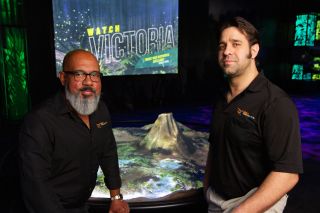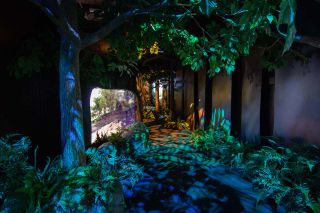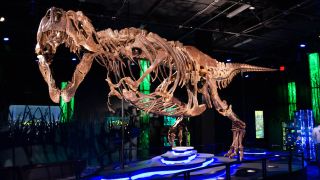Emerging technologies are pushing their way into many verticals, with exciting results. Museums and exhibitions offer an exciting opportunity to use technology to create immersive experiences that resonate with audiences of all ages. At the Victoria: The T-Rex exhibition, which recently opened at the Arizona Science Center in Phoenix, production company IMG and its integrator partner, Design Electronics, launched a trio of technologies that are sure to draw visitors into this extinct world.
[Interactive Tech Tells Important Story at the Museum of Natural History]
“Our needs analysis always begins with developing a deep understanding our client’s vision for the experience,” said Khalil Williams, CEO of Design Electronics. “In this case, the primary goal was to use technology to transport visitors to a bygone era, so they could experience what the world was like when dinosaurs ruled the earth.”
“We’re so excited to bring such a striking, unique example of a T-Rex to Phoenix,” chief curiosity officer Sari Custer said. “We are the first stop on Victoria’s premier tour, and people love to see dinosaurs.”
The skeleton, discovered near Faith, SD in 2013, measures 40 feet long by 12 feet high. According to Heinrich Mallison, lead paleontologist on the Victoria project, it’s the second most complete set of fossilized tyrannosaurus rex bones ever discovered. Science has shown that she was a sub-adult, aged 18-25 years at the time of death, and weighed 10.5 tons.
Making and Introduction
The journey begins in an intro theater with a 3-minute video providing insight into what Victoria’s life was like. The content sets the tone for entering into the dinosaur age. Design Electronics wanted to create this immersive experience with strong visuals and audio. The firm chose the Barco F70-4K8 projector for the visuals because the color processing presents crisp, bright imagery to tell the story of Victoria, her discovery, and what her world was like. This projector has also proven robust and durable for touring operations, as the team learned from past experience.

The audio magic is created by a Bose Professional RoomMatch system providing even and visceral SPL throughout the theater, complete with softly thundering background steps and rustling that makes visitors look over their shoulders.
[High Tech Storytelling: Museums, Exhibits, and AV]
The entry door opens, and patrons are ushered into the main exhibition, where the centerpiece is Victoria herself. She’s a 66-million-year-old T-Rex skeleton, and thanks to modern science, we can reach back into the past to learn about how she lived, and even how and when she died. The additional sections of the exhibition all relate to Victoria and her environment, enabling visitors of all ages to experience the age of the dinosaurs as never before.
Mapping Out Time
Exhibition creators wanted visitors to travel back to the dinosaur age and get a sense of what it was like to live in that time. A round surface was fabricated by Ravenswood Studio to replicate the terrain on which Victoria might have roamed. A volcano is one imposing feature, and there are valleys, thick undergrowth, and hills undulating over the landscape.

From high above, Design Electronics mounted and edge-blended two Barco G-series projectors that map onto the fabricated surface a timelapse of the landscape. Various dinosaurs enter the scene, the volcano builds up steam, and then erupts in a flurry of light and sound. Design Electronics chief technology officer Felice Taddeo was responsible for this area of the exhibition. The team is particularly excited that is the first use case in a museum setting for the value-engineered Barco G-series.
[5 Ways 5G Could Impact Museums]
“Projection mapping is a technology vehicle that draws you into the scene,” Taddeo said. “Seeing what life might have been like for these dinosaurs is mesmerizing. I’ve seen visitors of all ages stand at this part of the exhibition and watch it all the way through many times over. Some even move around it to see it from various angles.”
Making a Dinosaur
Three interactive holograms with bespoke software by NGX Interactive give patrons the opportunity to create their own dinosaur by selecting various attributes. Once they have built their creature, they cast images into a dynamic video landscape to see it in action.

Three stations allow multiple members of a single family or group to create dinosaurs at the same time, making the experience even more engaging. As patrons build their dinosaur, it’s displayed in an encased acrylic cube. When finalized, it’s launched into the virtual landscape, so that its creator can watch their dinosaur interact with the world around it.
[National Gallery X Explores the Future of Museum Tech]
Tunneling Through Time
Nothing is more immersive than being fully surrounded by props, lights, and sounds. The final portion of the exhibition, guiding the way to the gift shop and exit, is a tunnel diorama that resembles a lush forest. This experience was taken to the next level with virtual lighting and projection-mapped lizards, bugs, birds, and other creepy-crawly things that scamper around as a video montage tells the story of birth through to the moment of extinction.

Medialon Showmaster LE is the control platform for the diorama. Guests experience 61 different audio tracks played from a Medialon Mas Pro Dante, seamlessly mixed and delivered to the Bose speakers with Dante. Bose amplifiers supply the power, and the mood is enhanced with customized video and lighting. Combined, the technology leaves guests with a lasting impression.
[King Tut Exhibition Immerses Visitors With AV]
At the end of the diorama, a combination of bass shakers, lighting cues, and overhead video envelopes guests in an environment the dinosaurs must have felt in their final moments. Visitors then pass through a video gallery where they hear and see highlights from the paleontologists involved in the excavation. The key players talk about what makes Victoria unique and special.
Harnessing Potential
Museums present one of the most compelling use cases for the innovative deployment emerging technologies. Instead of a branded message, museums are focused on telling a story, capturing a moment in time, and taking guests to a new level of immersive experience. Technology facilitates that experience.
As new, more versatile products enter the marketplace, the opportunity for ever-more flexible video surfaces for both projection and LED technology are sure to set the scene for ever greater things ahead.


